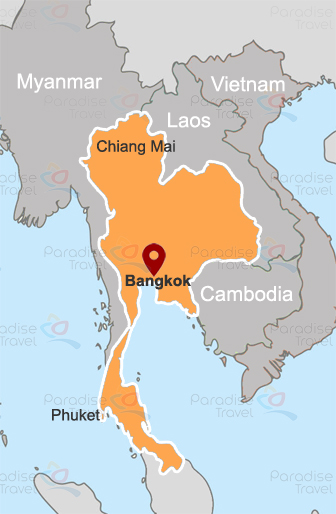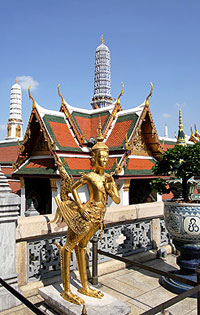Bangkok Travel Guide
 Bangkok was founded as Thailand’s capital in 1782 by King Rama I, the first monarch of the present Chakri dynasty. By far is the largest city of Thailand with an estimated of about 10 million, more than 10% of the country’s population, however the city receives continuously a great number of immigrants.
Bangkok was founded as Thailand’s capital in 1782 by King Rama I, the first monarch of the present Chakri dynasty. By far is the largest city of Thailand with an estimated of about 10 million, more than 10% of the country’s population, however the city receives continuously a great number of immigrants.
Bangkok covers an area of more than 1500 square kilometers spread across a flat alluvial plain divided by the Chao Phraya River. Over the last decades, Bangkok has changed into a modern, exciting and sophisticated city, combining successfully its ancient traditions and the modern progress.
Today, Bangkok is one of Orient’s most cosmopolitan cities, the city has become the country’s spiritual, diplomatic, industrial, commercial and educational centre, it is the usual residence of the Royal Family, it is the seat of Government and administration, it is the main port of the country. Bangkok is also the principal gateway and prime tourist attraction, the city has attractions to stimulate both domestic and international travelers; it is one of the Asia’s jewels. Its proper name is Krung Thep, which can be translated as “City of Angels”, it is the first two of more than fifty syllables that properly define the place; the full name of Bangkok is listed by Guinness Book of Records as the world’s longest place name. To the Thais, Bangkok is the spiritual and symbolic heart of its nation. Thailand was never colonized and thus kept its unique culture and heritage intact, Bangkok preserve its cultural heritage especially in the old areas around the Grand Palace, the Temple of the Emerald Buddha, the Temple of the Dawn and other historic shrines. The influence of the past continues to color daily life, for example, monks keep their traditions since centuries ago.
The City of Angels has a feast of attraction to offer, major tourist attractions include Buddhist Wats, golden temples, canal scenes, zoos, floating markets. The most spectacular sights are Wat Po, the temple where the large Reclining Buddha is located; Wat Traimit where you can see the large solid gold Buddha, the National Museum which serves as a introduction to the county’s history, the Red Cross Snake Farm, the Jim Thompson’s House, the Wat Arun or Temple of Dawn, the Rattanokosin Isle, Banglamphu district and the majestic Wats that flank the Grand Palace in which the temple of the Emerald Buddha is found; a worth of visit is the market at Chatuchak Park, near Northern Mo Chit Bus Terminal which is open weekends. Bangkok embraces modern development and has everything the modern traveler could enjoy.

The city has world-class hotels, glittering shopping centers, restaurants serving authentic Thai specialties, and an amazing nightlife which offers a wide range of entertainment – concerts, go-go bars, cinemas, discos, and shows – almost everything you want is available in Bangkok. The Bangkok’s red-light district is Patpong, the area is a couple of blocks between Silom and Suriwong Roads near the Sala Daeng Skytrain Station. Patpong has also a vibrant night market and very good dining options. In Bangkok you can at one moment be in the 21st century and the next walking through the past.
